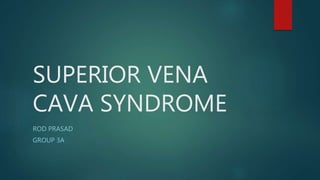
Superior vena cava syndrome
- 1. SUPERIOR VENA CAVA SYNDROME ROD PRASAD GROUP 3A
- 2. HISTORY First recorded description of SVC obstruction - 1757 when William Hunter described the entity in a patient with a syphilitic aortic aneurysm. For nearly two centuries – non-malignant processes such as aortic aneurysms, syphilitic aortitis, or chronic mediastinitis due to tuberculosis were the predominant etiologic factors. Subsequently, malignancy became the most common cause, accounting for 90% of cases by the 1980s. More recently, the incidence of SVC syndrome due to thrombosis has risen, largely because of increased use of intravascular devices such as catheters and pacemakers. Benign causes now account for 20 to 40 percent of cases of SVC syndrome.
- 3. INTRODUCTION Superior vena cava syndrome is a collection of clinical signs and symptoms resulting from either partial or complete obstruction of blood flow through the SVC. This obstruction is most commonly a result of thrombus formation or tumor infiltration of the vessel wall. The resulting venous congestion produces a clinical scenario relating to increased upper body venous pressures. The most common signs and symptoms include face or neck swelling, upper extremity swelling, dyspnea, cough, and dilated chest vein collaterals.
- 4. ETIOLOGY The majority of SVC syndromes are the result of mediastinal malignancies, primary among which is small cell bronchogenic carcinoma. The second most commonly associated malignancy is non-Hodgkins lymphoma, followed by metastatic tumors. In addition, benign or nonmalignant causes of superior vena cava syndrome now comprise at least 40% of cases. Iatrogenic thrombus formation or SVC stenosis is a growing etiology due to pacemaker wires and semipermanent intravascular catheters used for hemodialysis, long term antibiotics, or chemotherapy.
- 5. ETIOLOGY
- 6. PATHOPHYSIOLOGY Collateral veins may arise from the azygos, internal mammary, lateral thoracic, paraspinous, and esophageal venous systems. The venous collaterals dilate over several weeks. Upper body venous pressure is markedly elevated initially but decreases over time. Symptoms and signs from SVC obstruction depends upon the rate at which complete obstruction of the SVC occurs in relation to the recruitment of venous collaterals. Malignant disease - symptoms of SVC syndrome within weeks to months. Rapid tumor growth does not allow adequate time to develop collateral flow.
- 7. PATHOPHYSIOLOGY In contrast, fibrosing mediastinitis due to an infection such as histoplasmosis may not become symptomatic for years. Edema - Narrow the lumen of the nasal passages and larynx, potentially compromising the function of the larynx or pharynx- dyspnea, stridor, cough, hoarseness, and dysphagia. Cerebral edema can also occur and lead to cerebral ischemia, herniation, and possibly death. Cardiac output is diminished transiently by acute SVC obstruction. Within a few hours, blood return is re-established by increased venous pressure and collaterals. Hemodynamic compromise, if present, more often results from mass effect on the heart than from SVC compression.
- 9. SYMPTOMS Dyspnea Distended veins Edema of the face, neck, upper body and arms Coughing (with or without blood) Hoarseness Chest pain Difficulty swallowing Cyanosis Horner’s syndrome, which includes small pupil, drooping eyelid and no sweating on one side of the face. Paralysed vocal cord Headache Anxiety Dizziness Confusion
- 10. SYMPTOMS
- 11. INVESTIGATIONS Radiological CXR CT MRI USG Contrast enhanced venography Histological Bone marrow biopsy Lymph node biopsy Sputum/ pleural fluid cytology Explorative Bronchoscopy Thoracocentesis Thoracotomy
- 12. CHEST RADIOGRAPH Mediastinal widening. Venous collaterals: Large Azygous vein Mediastinal/ hilar mass Pleural effusion Calcifications
- 13. CHEST CT Defines the level and extent of venous blockage. Identification of the underlying cause of venous obstruction. Identify and map collateral pathways of venous drainage. Presence of collateral vessels on CT is a strong indicator of SVC syndrome. Specificity of 96 percent and sensitivity of 92 percent.
- 14. CONTRAST VENOGRAPHY Bilateral upper extremity venography is the gold standard for identification of SVC obstruction and the extent of associated thrombus formation. Superior to CT for defining the site and extent of SVC obstruction and for visualizing collateral pathways. It does not identify the cause of SVC obstruction unless thrombosis is the sole etiology.
- 15. OTHER INVESTIGATION MR VENOGRAPHY Magnetic resonance venography (MRI) is an alternative approach that may be useful for patients with contrast dye allergy or those for whom venous access cannot be obtained for contrast enhanced studies ULTRASOUND Exclusion of thrombus in upper extremity, axillary, subclavian, and brachiocephalic veins. HISTOLOGICAL Histologic diagnosis is a prerequisite for choosing appropriate therapy for the patient with SVC syndrome associated with malignancy.
- 16. GRADING SCVS
- 18. MANAGEMENT Management of the SVC obstruction itself is dictated by the severity of the symptoms, the likelihood of response to a particular treatment, and the treatment of the malignancy itself. Thus, the right approach will be influenced by the symptoms, the type and stage of malignancy, the patient's performance status, and comorbidities. When symptoms are life threatening (grade 4), immediate intervention is indicated and should be directed at urgent relief of the SVC obstruction. Intravascular stenting is safe and provides the most immediate relief. Stenting can often be accomplished even if there is complete SVC obstruction or thrombosis, particularly if thrombolytics are first used.
- 19. MANAGEMENT If symptoms are not life threatening, the ultimate outcome and survival from SVCS is dependent on the underlying root cause. Therefore, patients with grade 1 and 2 and most with grade 3 symptoms should undergo diagnostic and staging procedures to define the tumor type and stage. Patients with lymphoma, small-cell lung cancer, and germ cell tumors should experience a rapid clinical response from systemic chemotherapy.
- 20. THANK YOU!!!
